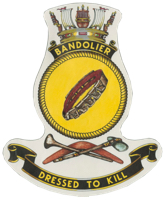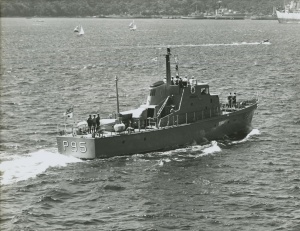HMAS Bandolier
| Type |
Attack Class Patrol Boat |
|---|---|
| Pennant |
95 |
| Builder |
Walkers Ltd, Maryborough Queensland |
| Commissioned |
14 December 1968 |
| Decommissioned |
16 November 1973 |
| Dimensions & Displacement | |
| Displacement | 146 tonnes |
| Length | 32.7 metres |
| Beam | 6.2 metres |
| Draught | 1.9 metres |
| Performance | |
| Speed | 24 knots |
| Armament | |
| Guns | 1 x 40mm Bofors, 2 x .5 inch Browning machine gun |

The Royal Australian Navy’s experience during the Indonesian Confrontation had led the RAN to reconsider the specific roles of some its surface warships, including the lack of a suitable patrol vessel. The Ton class minesweepers had performed patrol operations admirably during Confrontation; however, while suitably armed for the task, their overall design was not appropriate for extended patrol work. Consequently, an order was placed for 14 Attack Class patrol boats to be constructed in Australia, including five for service with the RAN’s Papua New Guinea Division. The order was later expanded to 20.
In 1965 two Queensland shipbuilders, Evans Deakin Ltd in Brisbane and Walkers Ltd in Maryborough, were contracted to build the vessels for delivery by August 1966. Both yards had built vessels for the RAN during World War II but had not undertaken substantial naval construction since. As a result, early construction proved slow and the first keel was not laid until September 1966; however, once construction got underway and the yards got up to speed, the build time was greatly reduced.
The hulls were of steel construction and prefabricated in seven sections while the upper-works were made of aluminium. They were equipped with high-definition navigation radar, magnetic compasses, an echo sounder and air conditioning for service in northern Australian waters. The Attack Class patrol boats proved to be capable vessels, and were used chiefly in maritime security and surveillance, border protection and fishery patrol duties.
HMAS Bandolier was built at the Walkers Yard in Maryborough. The ship was commissioned into the RAN on 14 December 1968 under the command of Lieutenant Commander John Toulouse, VRD, RANVR. Following her commissioning and acceptance Bandolier made her way to Sydney where Lieutenant Ross Blue, RAN, assumed command.
Bandolier took part in exercises in the Sydney/Broken Bay/Jervis Bay area in early 1969 with members of the RAN Clearance Diving Teams and Australian Army Commandos. She also conducted exercises in Port Stephens. That March Bandolier shaped course for Hobart with clearance divers embarked to dive on the wreck of the iron barque, Brier Holme, which had been lost in a gale on the south west coast in 1904 with just one survivor from her crew of 19. Poor weather precluded the dive, however, and the ship returned to Sydney.
Bandolier’s brief commission in the RAN came to an end on 17 March 1969 when she was placed into operational reserve. She was transferred to the Indonesian Navy on 16 November 1973 and renamed KRI Sibarau.




